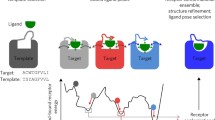Abstract
It is often difficult to differentiate effectively between related G-protein coupled receptors and their subtypes when doing ligand-based drug design. GALAHAD uses a multi-objective scoring system to generate multiple alignments involving alternative trade-offs between the conflicting desires to minimize internal strain while maximizing pharmacophoric and steric (pharmacomorphic) concordance between ligands. The various overlays obtained can be associated with different subtypes by examination, even when the ligands available do not discriminate completely between receptors and when no specificity information has been used to bias the alignment process. This makes GALAHAD a potentially powerful tool for identifying discriminating models, as is illustrated here using a set of dopaminergic agonists that vary in their D1 vs. D2 receptor selectivity.






Similar content being viewed by others
Notes
Just as for bitmaps, the count vector is actually created and manipulated in compressed form.
References
GALAHAD®, Tuplets™, GASP™ and SYBYL® are available from Tripos International, 1699 S. Hanley Rd., St. Louis, MO 63144, USA. http://www.tripos.com
Clark RD, Abrahamian E, Strizhev A (2007) US Patent Application 20070143030. Accessible at http://appft1.uspto.gov/netahtml/PTO/srchnum.html
Richmond NJ, Abrams CA, Wolohan PRN, Abrahamian A, Willett P, Clark RD (2006) J Comput Aided Mol Des 20:567–587. doi:10.1007/s10822-006-9082-y
Abrahamian E, Fox PC, Nærum L, Christensen IT, Thøgersen H, Clark RD (2003) J Chem Inf Comput Sci 43:458–468. doi:10.1021/ci025595r
Jones G, Willett P, Glen RC (1995) J Comput Aided Mol Des 9:532–549. doi:10.1007/BF00124324
Richmond NJ, Willett P, Clark RD (2004) J Mol Graph Model 23:199–209. doi:10.1016/j.jmgm.2004.04.004
Gillet and coworkers have explored different approaches to incorporating multi-objective fitness and partial match capability into GASP. For details, see: Cottrell SJ, Gillet VJ, Taylor R (2006) J Comput-Aided Mol Des 20:735–749. doi:10.1007/s10822-004-5523-7
Gillet VJ, Khatib W, Willett P, Fleming PJ, Green DVS (2002) J Chem Inf Comput Sci 42:375–385. doi:10.1021/ci010375j
Coello CAC, Van Veldhuizen DA, Lamont GB (2007) Evolutionary algorithms for solving multi-objective problems. Springer, New York
Clark RD, Fox PC, Abrahamian E (2005) In: Alvarez J, Shoichet B (eds) Virtual screening in drug discovery. CRC Press, Boca Raton, pp 207–225
Abrahamian A, Clark RD, Fox P, Metwally E (2007) US Patent No. 7,212,951
Shepphird JK, Clark RD (2006) J Comput Aided Mol Des 20:763–771. doi:10.1007/s10822-006-9070-2
Cottrell SJ, Gillet VJ, Taylor R, Wilton DJ (2004) J Comput Aided Mol Des 18:665–682. doi:10.1007/s10822-004-5523-7
Cvetković D, Coello CAC (2005) In: Jin Y (ed) Knowledge incorporation in evolutionary computation. Springer, New York, pp 479–503
Wilcox RE, Tseng T, Brusniak M-YK, Ginsburg B, Pearlman RS, Teeter M et al (1998) J Med Chem 41:4385–4399. doi:10.1021/jm9800292
CONCORD® was developed by R. S. Pearlman, A. Rusinko, J. M. Skell and R. Baducci at the University of Texas, Austin, and is distributed exclusively by Tripos International, 1699 S. Hanley Rd., St. Louis, MO 63144
Halgren TA (1999) J Comput Chem 20:730–748. doi:10.1002/(SICI)1096-987X(199905)20:7<730::AID-JCC8>3.0.CO;2-T
Duewer DL, Clark RD (1991) J Chemometr 5:503–521. doi:10.1002/cem.1180050604
Acknowledgment
The suggestions provided by anonymous reviewers contributed significantly to the clarity and readability of this paper, and the authors appreciate their thoughtful criticisms.
Author information
Authors and Affiliations
Corresponding author
Rights and permissions
About this article
Cite this article
Clark, R.D., Abrahamian, E. Using a staged multi-objective optimization approach to find selective pharmacophore models. J Comput Aided Mol Des 23, 765–771 (2009). https://doi.org/10.1007/s10822-008-9227-2
Received:
Accepted:
Published:
Issue Date:
DOI: https://doi.org/10.1007/s10822-008-9227-2




